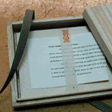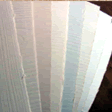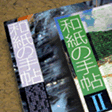
 |
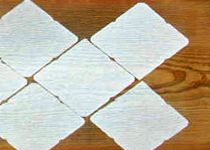 |
|||
 |
||||
|
|
A Guide to the ”Ino-cho Kamino Hakubutsukan” (Ino-cho Paper Museum) Taking the tramline from Kochi City, after a journey of approximately one hour through the peaceful countryside, I reached Ino-cho where Tosa handmade washi was born. The Ino-cho Paper Museum is housed in a building with magnificent black roof tiles. In the museum, the process of handmade paper is exhibited according to each stage, making it easy for the visitors to understand the tedious process. Rare old washi making equipment are also displayed in the exhibition space. Tosa washi has a history of over one thousand years, and has been mentioned in the "Tosa Nikki” (Tosa Diary written in 934), as Kino Tsurayuki, during his term as a government official, promoted paper manufacturing industry as a local industry. The history of Tosa washi is explained through these documents in the museum, and portrays how paper making flourished as a prominent industry since the olden times. The museum also has a workshop where visitors can experience hand-making washi. Being the home of washi, it provides wide selection of washi and washi products for sale as well.
Tosa
Washi Traditional Industry Hall tel: 0888-93-0886 Related
site:
|
|||||||
|
|
||||||||
|
|
|
|||||||
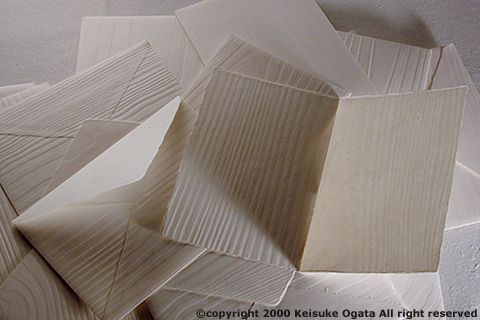 |
||||||||
|
|
||||||||
|
|
Other Itamegami Sizes AvailableThere are many that are fond of paper and enjoy having a stock of paper for no specific reason. For people with such interests, or others who wish to decorate washi on the walls as wall paper, hang washi partition screens from the ceiling, utilize washi as folding screens or as paper for silk-screens, (photo 3, works by German artist, etching), Okatsu-san has prepared a larger convenient sized itamegami (55cm x 45 cm). Colors other than white, prepared with vegetable dyes, such as Japanese ink black, pale pink are also available (photo 4, indigo blue, crimson, plum dyed washi). For the colored paper orders will be taken from 100 sheets.
|
|||||||
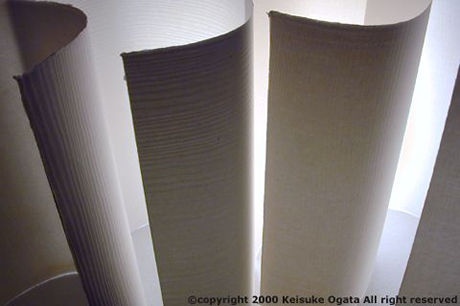 |
||||||||
|
|
||||||||
|
Large Sized ItamegamiWashi wholesale dealers
and specialty stores provide a wide assortment of washi produced
from every part of Japan. When in search of purchasing few sheets
of washi, it is best to visit these stores, and actually hold the
paper in your hand and feel the thickness, texture and see the colors. However, when purchasing washi for wood block prints or copper plate etching, or when in search of specific type of washi for interior uses, it is best to find a skilled washi maker that can provide the paper fit for your individual taste and needs. One of the four young washi makers, Ryouji Tamura, welcomes personal orders. Before he decided to return to his hometown, Tamura-san was working at a company manufacturing prototypes for car systems. After studying at a paper industry laboratory, in 1997 he decided to start his own paper workshop, and continues to make handmade washi available at Tosa Washi Paper Craft Center located in Ino-cho. Tamura-san first received an order from an architect to experiment creating a large sized itamegami. His paper called "Daito-shi” (76 cm x 142 cm in size), is made of either 100% kozo, or 100% mitsumata. He has specially agreed to take orders for these large sized washi, starting from orders of 100 sheets. The price range is for both kozo,or mitsumata sheet, approximately 2,000 to 3,000 Japanese yen (depending on the thickness). In addition, other sizes yotsu-ban (sizes 55 cm x 142 cm), uda-ban (sizes 40 cm x 142 cm) can also be prepared upon request.
|
||||||||
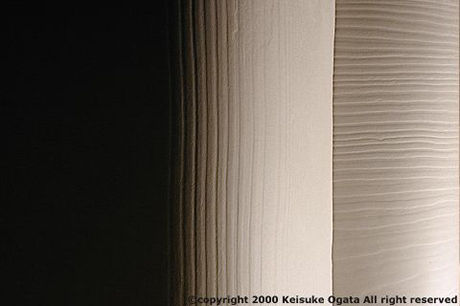 |
||||||||
|
|
||||||||
|
|
Rare books on WashiPocket Book on Washi
I (in Japanese), Pocket Book on Washi II (in Japanese),
and Handbook on the Art of Washi (in English), are useful
books published by All Japan Handmade Washi Association, that introduces
everything you need to know about washi ( Pocket Book on Washi
I, Pocket Book on Washi II (photo 5), and Handbook on the Art
of Washi (photo 6). These books were published to have more people
learn and be aware of the art of washi. These books are not sold
in bookstores. Although it is not widely known by the public, it
is its fifth edition and can be said to be a secret bestseller. In the Pocket Book on Washi I, there are 50 questions regarding washi, answered by experts in each individual field. It also lists famous places where they are produced, and their characteristics, where you can buy them, where you can experience making them. It is a very practical book, greatly recommended for people interested in washi. Sample questions:
In the Pocket Book on Washi II, one finds 50 different questions regarding washi, that were not answered in Pocket Book on Washi I. Sample questions:
Handbook on the Art of Washi selects 43 interesting questions from both Pocket Book on Washi I & Pocket Book on Washi II, and is printed in English. Sample questions:
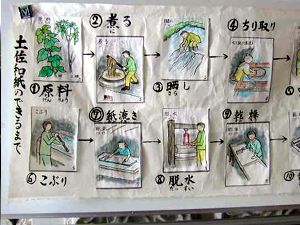 A colorful poster drawn by children, explaining how washi is made. Tosa Washi Traditional Industry Hall
|
|||||||

